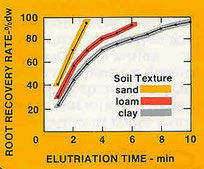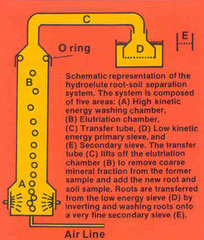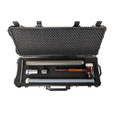Semi-Automated Root Washing System
Hydropneumatic Root Elutriation Device

Root Washer. Separating roots from mineral soil cores by hand is laborious and costly. The hydropneumatic root elutriator ("root washer"), build by Gillison's and used for decades in multiple North American research institutions, can semi-automate the job - significantly speeding up the process and reducing labour costs. In the Root Washer system, a combination of hydraulic and pneumatic systems ("hydropneumatic") elutriate the roots from the soil while an electric timer controls the washing process. The extruded steel frame of the elutriator serves a dual purpose; structural support and transport of water and compressed air. Water is transported in the lower portion and air in the upper portion of the hollow interior of the extruded steel frame. They exit the frame in polyethylene tubes that extend to the bottom of the elutriator tubes ("washing chambers"). Soil samples with roots are placed in the tubes of the elutration washing system, and the roots float to a sieve system at the top for collection. Washed out soil is occasionally collected from the lower settling basin, greatly reducing the risk of clogged drains, and the water is discharged to any sink. Different sieve diameters (210 µm, 297 µm, 350 µm, 500 µm and 1000 µm for clay to sand) and washing times (e.g. 3–12 minutes) can be combined to determine optimized washing cycles for different soil x root types (see below). The semi-automated elutriation system / root washer is available for rinsing 4 or 8 soil cores / root samples in parallel; the unit for 8 soil samples can be designed as a corner unit (see figure).
Root Washer - Features

- 4 or 8 parallel root washing chambers for efficient root elutriation (see figure) through pressurized spray kinetic energy (3 water sprayers, 1 air injector per tube) and low-energy air flotation (see schematics below)
- Periods of automatic root washing set individually per washer tube
- Various sizes of collection sieves are available to allow a wide range of soil x root combinations to be processed.
| Specifications | Root Washer 4 Units | OPEN |
Customer must provide for root washer operation: Water (tap water, or tank with pump), compressed air (bottled, or compressor), & electricity (110-240V).
Optional items:
|
||
| References | Root Washer | OPEN |
|
||
Plant Root Elutrator - Operation Procedure

- Turn on the air supply / compressor and set the pressure gauge to ~ 0.48 MPa (4.9 bar, 7 psi), then turn on the water supply and set the pressure to a minimum of 0.35 MPa (3.5 bar). The washing chamber (A) will operate at optimum efficiency at ~0.42 to 0.5 MPa (4.2 to 5 bar, 60-70 psi).*
- Place soil and root samples of ~150 cm³ (27 cubic inches) into the tube ("elutration chamber" B, from top).
- Continue reading on the operation procedure.. Show more
-
- Position the transfer tube (C) on top of the washing chamber B and attach the primary / "low energy" sieve (D), selecting the appropriate sieve size (210 - 1000 µm) based on the soil particle size. The sieve should be small enough to retain the smallest root segments, but not too small to cause sieve clogging by soil particles.
- Set the timer to the recommended run time (see Table 1) to activate the wash cycle per tube. Quantitative separation of the roots is then achieved by a closed system of mechanical separation using water and air to isolate and deposit the roots on the sieve on top (D).
- After the timer has completed its cycle, remove the primary sieve (D) and transfer tube (C) and inspect the soil particles remaining in the wash chamber (A) for roots. If the chamber is root free, this indicates that the wash time may have been fine (or too long). If roots are still present, increase the rinsing time until the soil in the chamber is root free. Repeat this process several times initially to establish an efficient protocol.
- Use the sprayer on the top of the Hydroelute System to flush the roots from the primary sieve into a secondary sieve (E). Proces roots further if needed (e.g. removing organic debris roots have grown into, select roots for scanning, etc.)
- After removing the transfer tube C, invert the chamber B to drain the water and soil residue into the lower sedimentation basin.
- Set the flush timer for 30 seconds to flush the inverted tube debris into the lower sedimentation basin. Periodically remove sediment from the upper and lower sedimentation basins by hand or with the sprayer / small shovel to prevent potential blockage of flow through the primary screening/drainage system.
- Process roots, e.g. by immediate 2D imaging for morphological root traits, or store for later analysis.
Original publication: Smucker, A.J.M., McBurney, S.L., & Srivastava, A.K. (1982). Quantitative separation of roots from compacted soil profiles by the hydropneumatic elutriation system. Agronomy Journal, 74(3), 500-503.
*Common water pressure in Vienna e.g. 0.5 MPa - more than sufficient. Contact your local water supplier, or use a pump system + tank filled with rain or groundwater for washing.
| Operation | Typical Root Wash Times | OPEN | ||||||||||||||
|
Table 1. Typical wash times for each soil type. These times may vary depending on the amount of organic matter, clay type, plant root density and degree of soil compaction.
|
||||||||||||||||
Soil corer kit for taking soil and root samples for the hydro-pneumatic semi-automatic Root Washer. A hand corer for root sampling in the topsoil is available.







